|
Equity Issues in a Green Economy
"Equity represents a belief that there are some things which people must have..basic needs that should be fulfilled..policy should be directed with impartiality, fairness and justice towards these ends." - Falk et al, 1992
• Imbalances in the power structure and access to resources increases vulnerabilities and reduces resilience of the poor • It affects people’s capacity to take advantage of employment and other opportunities and to change their consumption patterns • Wide-scale income disparities creates social unrest leading to adverse impacts on public policy addressing problems of poverty eradication, climate change etc Liberalisation, technological innovation and
globalisation, all considered to be tools for greening the economy, have
contributed to creating barriers for equity. According to ADB (2012),
they have contributed to escalating global inequity, disproportionately
raising the income of the rich. These forces affect income differences
through three channels - capital, skill and spatial bias. More and more
emphasis is placed on the physical capital development as opposed to
human capital creating higher returns for the owners of physical
capital. The higher premium on the white collar jobs as compared to the
blue collar jobs is widening the wage differentials. The problem is
heightened by geographic divergences created by factors such as
infrastructure, scale of economy and market accessibility. Furthermore,
the "feminisation of poverty" (Carroll, 2012) is barring our
progress on socio-economic development outcomes. While green economy tries to include the social dimensions of sustainable development, it has not fully embraced the concept of equity (UNRISD). Equity matters for both instrumental as well as normative reasons such as fairness and meritocracy (Cobham and Sumner, 2013). The notion of equity encompasses not only equity between and within nations but also inter-generational balancing of needs and aspirations. While there is a global consensus on the need for transitioning to a greener economy which is equitable, there are a multitude of pathways available such as business as usual, piggy-back or leap frog. The complexity of the issues is compounded by the fact that each pathway exerts different positive and negative impacts on various socio-economic groups shaping a different role for actors such as the government, community, industry and markets etc. The relative low visibility of problem of inequity in the transition towards a green economy prevents governments to take a proactive role. Besides the lack of knowledge, every country’s need to safeguard its own interest further pushes a wait and watch approach. The evidence paints a disturbing picture of further marginalisation of the already disadvantaged and vulnerable groups. Hence, it becomes important to ensure that in this movement, patterns of inequity are not further reinforced and the focus remains on creating a just, fair and inclusive economy. Green economy and its impression of embracing the social dimension needs to now move beyond the rhetoric. We need to jettison the myopic lens of viewing equity through only income, as it ignores the vulnerabilities and inequities generated through other social and environmental components such as gender, access to resources and equal opportunities. Placing equity at the core of a green economy would mean moving beyond the current approach of technological fixes, market based approaches (pricing and privatisation) and soft policy reforms. Lievens argues for an explicit intervention in this "system of unsustainability" (SIDNL and ISS, n.d.). We need to adopt a "Social Green Economy" which would necessitate not only the broadening of our policy focus but also correcting the "imbalances in the orientation" of our policies (UNRISD, 2012). We need to look beyond the current focus on (a) protection and compensation (b) attaining co-benefits and helping in adaptations and actually anchor the structural transformations needed by looking at rights and regulations, opportunities and capacities available for our social processes and adopt a similar outlook for economic thinking (refer to the figure above). Green economy is not a static defined system. We are constantly learning more and through this process we need to identify how we can lessen inequity while transitioning towards a green economy. We need to identify what structural changes are needed, what new policies are relevant and where investments should be placed, how to create effective participation to define the right economic system for both the planet and every human being that lives on it. Read more: http://www.devalt.org/images/L3_ProjectPdfs/EquityInGreenEconomy_Final. pdf?mid=6&sid=28 qZeenat Niazi
|
.png) T
T